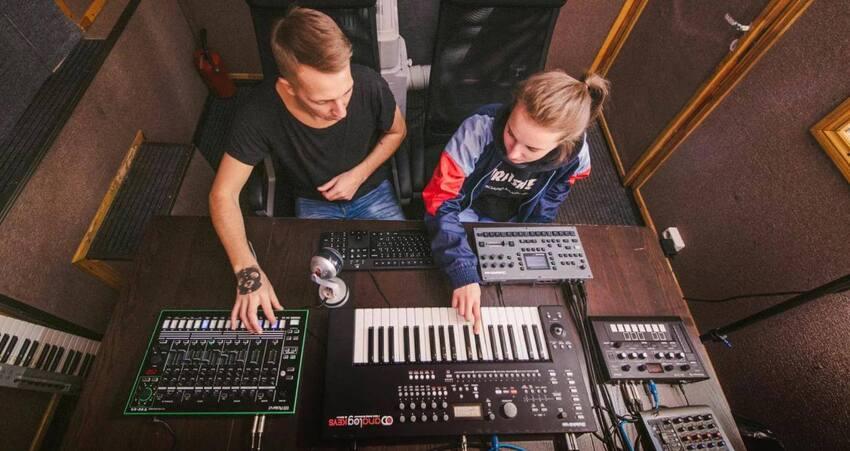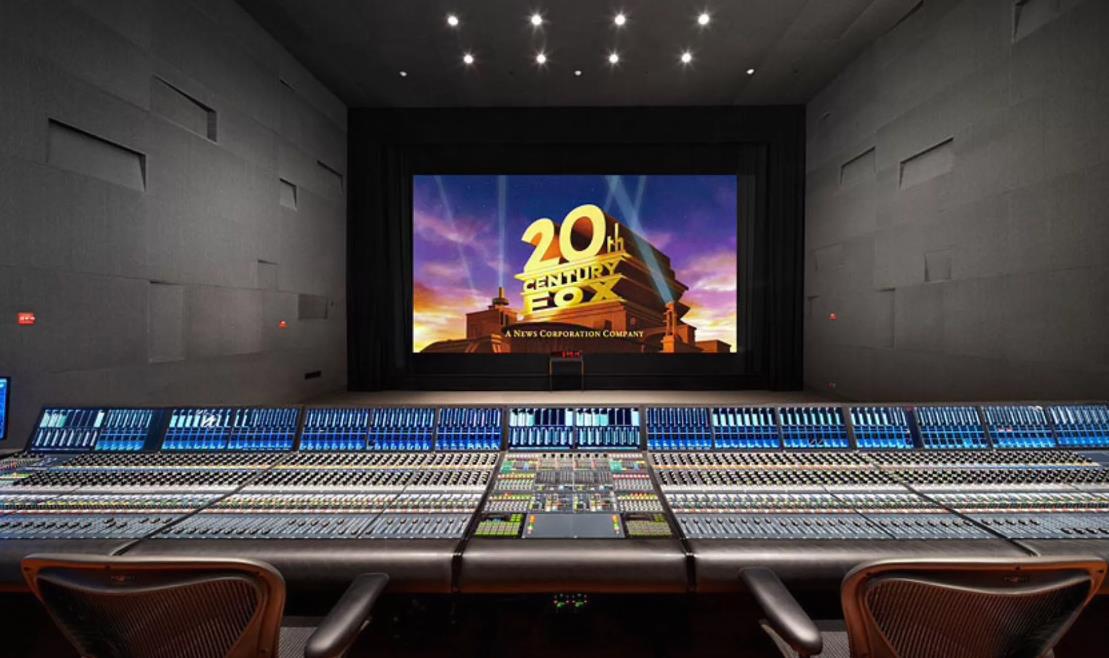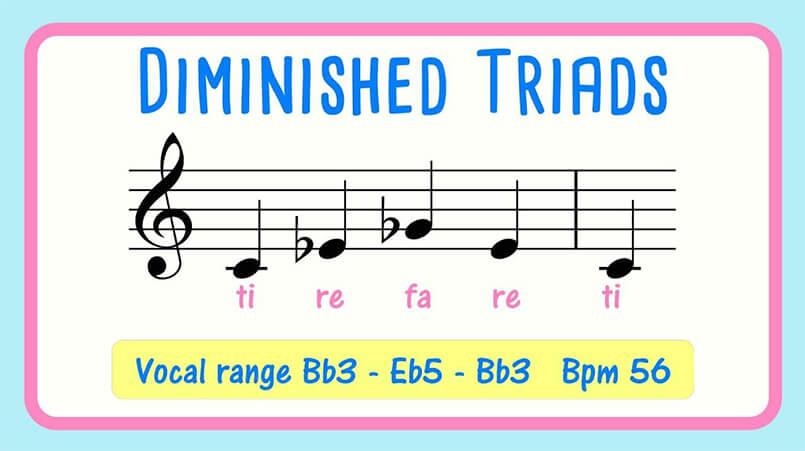Best midi interfaces for under $100

Getting into recording audio can be an expensive business. There’s a lot of gear you’ll need to get up and running and costs can quickly spiral out of control but it doesn’t have to be this way. In fact, we’d wager it’s much better to buy only what you absolutely need and work your way up from there, adding as you grow and evolve. One thing is certain however, if you want to start creating audio or content and spend wisely, you should start with one of the best budget audio interfaces.
There’s a humongous selection of audio interfaces available for home recording in 2024, and many of them are outstanding value for money. So how do you know which one is truly the best for you? Well here at MusicRadar we’ve reviewed more audio interfaces than you can shake a boom mic stand at, which puts us in the perfect position to recommend you the best possible bit of gear for your personal use case. All of the audio interfaces in our guides have been meticulously examined by our expert reviewers and used in actual musical or content scenarios, whether that’s recording guitars and vocals or live streaming Call of Duty games. We test audio interfaces by pushing them to their limits, trialling their usability in a variety of scenarios, and thoroughly examining them for all their pros and cons.
If you’re new to phrases like ‘headroom’ and ‘phantom power’, then its worth checking out our buying advice section where we’ve answered loads of common questions for the curious or budget conscious. If you just want to see the best value audio interfaces available today, then keep scrolling for our top choices.
1. Audient iD4 MkII

Inputs: 1 x ¼” input, 1 x XLR input
Outputs: 2 x 14” main out, 1 x ¼” headphone out, 1 x mini-jack out
Compatibility: PC, Mac, iOS
Max sample rate: 96kHz
Max resolution: 24-bit
Bundled software: Audient ARC software package
It doesn’t seem like all that long ago that Audient launched its smallest ever audio interface, the iD4. There’s always room to improve things though, which is why the Audient iD4 MkII is interesting. Where the first iteration won fans on account of its rigid build, superb audio fidelity and simplicity, the MkII takes these characteristics and introduces faster USB transfer speeds and USB-C connectivity.
There are some nice details included, like the extra headphone output and a smart scroll wheel which can be used to tweak settings in your software. And, speaking of which, the bundled ARC package contains plenty of plugins, effects and virtual instruments to get you up and running in no time. It might be a little pricier than other interfaces in this guide, but it’s a pretty comprehensive package all round.
2. Behringer U-Phoria UMC22
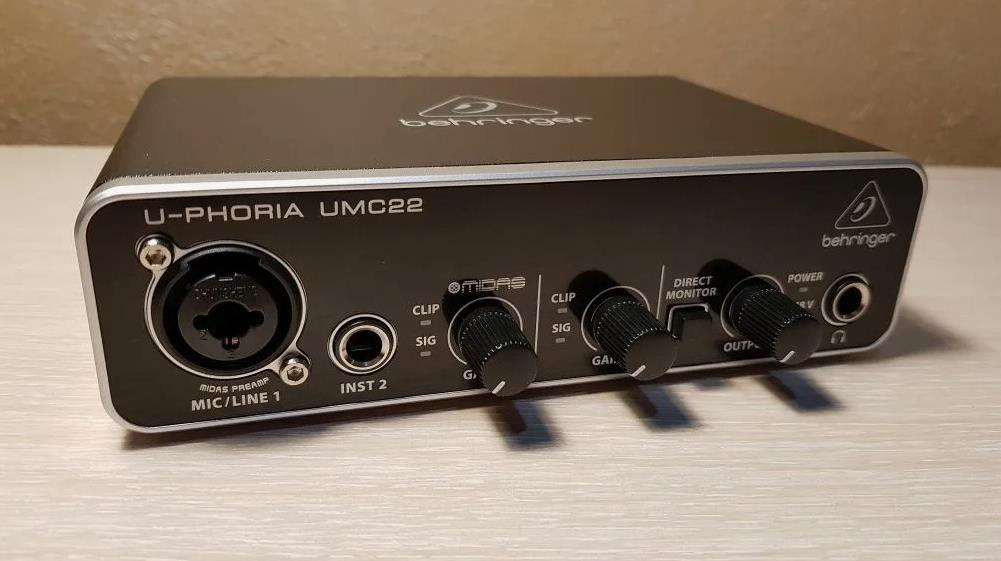
Inputs: 1x combo, 1x inst
Outputs: balanced TRS stereo pair, headphone
Compatibility: Mac, PC (requires ASIO4ALL)
Max sample rate: 48kHz
Max resolution: 16-bit
Bundled software: Traktion, UMC22 plugin bundle
We’ve placed takeaway orders that have cost us more than what Behringer’s UMC22 retails for, so it’s hard to quibble with this one on price. You do, of course, get what you pay for to some extent, and there are a number of areas where the UMC22 lags behind its pricier rivals.
For one thing, the max resolution here is 16-bit, which is still CD quality and will most likely be fine for most users, but is worth being aware of. The U-Phoria range doesn’t have its own designated driver either, and relies on the universal ASIO4ALL (although this is still a free download). Also, while build quality is in no way poor, we wouldn’t want to bet on the UMC22 outlasting the devices at the top of this list.
All that being said, there are no outright deal-breakers amongst these downsides and at this price, if you need something cheap to get going with, you could certainly do a lot worse.
3. Universal Audio Volt 1

Connectivity: USB-C
Audio resolution: 24-bit/192kHz
Analogue inputs: 1
Analogue outputs: 2
Digital connectivity: None
MIDI I/O: Yes
Highlights: Marshall Plexi Classic Amplifier, Live 11 Lite, Melodyne Essential and Ampeg SVT-VR bass amp
Universal Audio’s Volt 1 is one of the entry-level interfaces in UA’s Volt series. The Volt 1 is a plug-and-play USB-C interface that offers UA’s excellent preamps on a single combi input. They offer a great vintage tube sound on your inputs, giving recordings a richness rarely heard in this price range.
We love the compact size of the Volt 1, which makes it great for fitting into tight spaces or packing into a backpack to record on the go. As you’d expect from UA it’s got fantastic build quality too, so will stand the test of time despite being relatively cheap.
The Volt is a radical departure for UA, offering an affordable taste of the brand’s key ingredients. They’re incompatible with plugins from the UAD store but they absolutely deserve to shake up the budget end of the interface market with a great design, a plug-and-play workflow, and hard-to-beat audio conversion.
4. Focusrite Scarlett 4th Gen Solo

Connectivity: USB-C Audio
Resolution: 24-bit/192kHz
Analogue inputs: 2
Analogue outputs: 2
Digital connectivity: None
MIDI I/O: Yes, software bundle
Focusrite audio interfaces are long-established and available in many shapes and sizes. The latest 4th generation devices are the Solo, 2i2 and 4i4, with the first two falling very much within our budget interface remit.
The Solo includes 2 inputs (1 mic XLR and 1 line/instrument jack) and 2 outputs, and the 2i2 is also 2 I/O but with 2 mic preamps (2 XLR and 2 line/instrument connectors).
The interfaces retain the same red metal casework and functional shape of the 3rd gen, although the sizes and layouts have been modified.
There are technical improvements, with 120dB dynamic range, a new improved headphone amp, and a reworked Air mode, which adds presence to the higher frequencies of recordings.
Although they look similar, the new Scarletts are slicker audio interfaces with better specs and more options. They show there’s always room for development, and the new features will help improve your productivity and recordings.
5. Presonus Studio 24c
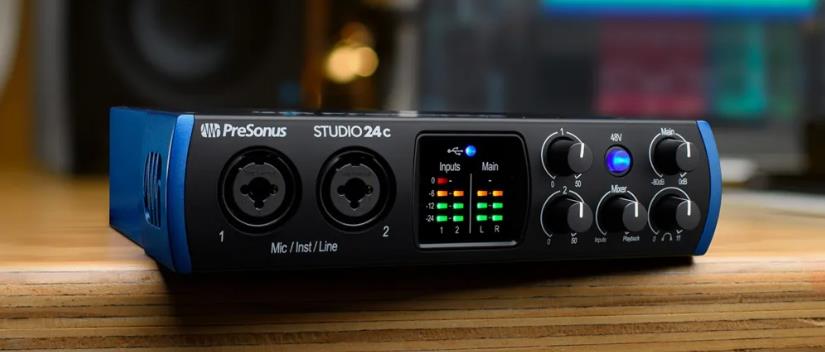
Inputs: 2 x ¼”/XLR combi inputs
Outputs: 2 x 1/4” main out, 1 x ¼” headphone out
Compatibility: PC, Mac, iOS
Max sample rate: 192kHz
Max resolution: 24-bit
Bundled software: Studio One Artist, Studio Magic Plug-in Suite
There are audio interfaces that aim to support specific musical disciplines like, for example, guitarists (check out our best guitar audio interfaces guide for more of that). And then there are jack-of-all-trades, which try to do a bit of everything, from speech to music. The Presonus Studio 24c is firmly in the latter camp, offering exceptional quality regardless of what you’re trying to record or produce.
We particularly like the included Universal Control software, which enables the interface to ‘loopback’ on itself virtually. This provides great flexibility for routing audio between different applications without requiring extra cables, making it ideal for streamers and musicians alike. Build quality is solid, and the MIDI connectivity to the back of the unit is a great touch.
6. Arturia Minifuse 1

Inputs: 1x combo
Outputs: 2 x 1/4″ TRS, headphone
Compatibility: PC, Mac, iOS, Android
Max sample rate: 192kHz
Max resolution: 24-bit
Bundled software: Ableton Live Lite, Analog Lab Intro, Auto-Tune (3-month subscription), GUITAR RIG 6 LE, Splice (3-month subscription)
Mainly known for their legendary soft synths, Arturia’s MiniFuse series represents a new foray into audio interfaces, and the MiniFuse 1 ticks two boxes by being both cheap and compact.
The preamp quality is excellent, with an impressive dynamic range of up to 110dB giving you crystal-clear audio. A useful direct monitoring button lets you switch between computer audio and direct, whilst an LED output meter shows you how hot your signal is.
It’s got a Hi-Z switch for using electric guitars and other non line level instruments, and has phantom power for using condenser microphones. It’s ruggedly built too, and combined with the small size it will easily put up with the rough and tumble of life on the road.
7. M-Audio M-Track Duo

M-audio M-Track Duo is one of the popular audio interfaces from M-Audio. This portable recording interface offers 48 kHz audio sampling resolution.
It is easy to use and is perfect for indie composers who are not tech geeks. This USB-powered device is compatible with Mac, PC, or iOS devices, so you can use it anywhere. That is why I introduced it to you as a portable audio interface.
Let’s take a look at the features of this audio interface.
M-audio M-Track Duo Features
- This is a two-channel USB recording interface compatible with both Mac and PC;
- You get 2 (amphibious) inputs with crystal clear sound quality and powerful preamps;
- You can turn on any microphone, instrument or line device using dedicated switches located under the inputs;
- +48V phantom power, suitable for condenser microphones;
- 1/4” stereo outputs and 1/4” headphone output;
- Independent level controls for headphone and stereo outputs;
- A USB/Direct Mono/Direct Stereo switch is provided for monitoring mic, line or instrument inputs in stereo or mono;
- This audio interface comes with this software – Pro Tools First, M-Audio Edition, MPC Beats, AIR Music Tech Xpand!2, Eleven Light guitar amp plug-ins and 20 Avid effects.
8. Behringer UMC22

The Behringer UMC22 is a 2X2 audio interface that supports up to 48 kHz. It is one of the cheapest audio interfaces in the world.
The Behringer UMC22 features one professional Midas microphone preamp with a combination XLR/TRS input, allowing you to use both mic and line-level instruments from the same connection. The other input is a phono preamp that can be used to record guitar and synths.
This audio interface is best suited for songwriters, indie music composers and performers.
Behringer UMC22 Features
- This is a two-channel USB recording interface that supports both Mac and Windows PC;
- Combo input with MIDAS preamp technology ensures accurate audio recording when connecting any microphone or line-level equipment;
- The first input provides +48 V phantom power, allowing you to use condenser microphones;
- Separate instrument-level input for guitar and bass instruments;
- Headphone and stereo 1/4″ outputs.
9. IK Multimedia iRig 2

IK Multimedia iRig 2 is a compact guitar interface that allows you to record guitar anywhere, anytime. It is a very compact audio interface with one input and one output.
You can connect this audio interface to anything from a mobile phone to an iPad. It is a dedicated guitar interface, so you will only have one input.
IK Multimedia iRig 2 Features
- This is an improved version of the best-selling iRig interface;
- Features a 1/4” instrument input for use with guitar, bass, etc.;
- You will get a 1/4” amp output for connecting an external amp;
- 1/8” TRRS output for connecting to iPhone, iPad, iPod touch and Mac;
- 1/8” headphone output;
- Extremely compact and lightweight design;
- Input gain adjustment using the control wheel;
- Includes a Velcro mount for a mic stand;
- Includes AmpliTube FREE for iOS (free download from the App Store).
9. Lexicon Alpha
![]()
Lexicon Alpha is a compact yet professional audio interface. It features a USB I/O mixer with 2 inputs, 2 buses and 2 outputs, plus a high-impedance instrument input.
You can use this USB audio interface anywhere with a laptop. You also get Cubase® LE 5 with the Lexicon Alpha audio interface. So there’s no need to buy a separate DAW.
Lexicon Alpha features one microphone input and three line inputs.
Lexicon Alpha Features
- This audio interface features separate mic and line input level controls, plus individual peak indicators for signal management;
- Monitor mix control knob for balancing the audio between the live input and playback mix level while recording. The output can be switched to stereo or mono;
- Headphone amplifier delivers powerful and ultra-clean sound that will drive any headphones;
- Line outputs with high-pass filtering and balanced TRS.
10. U-Control от Behringer
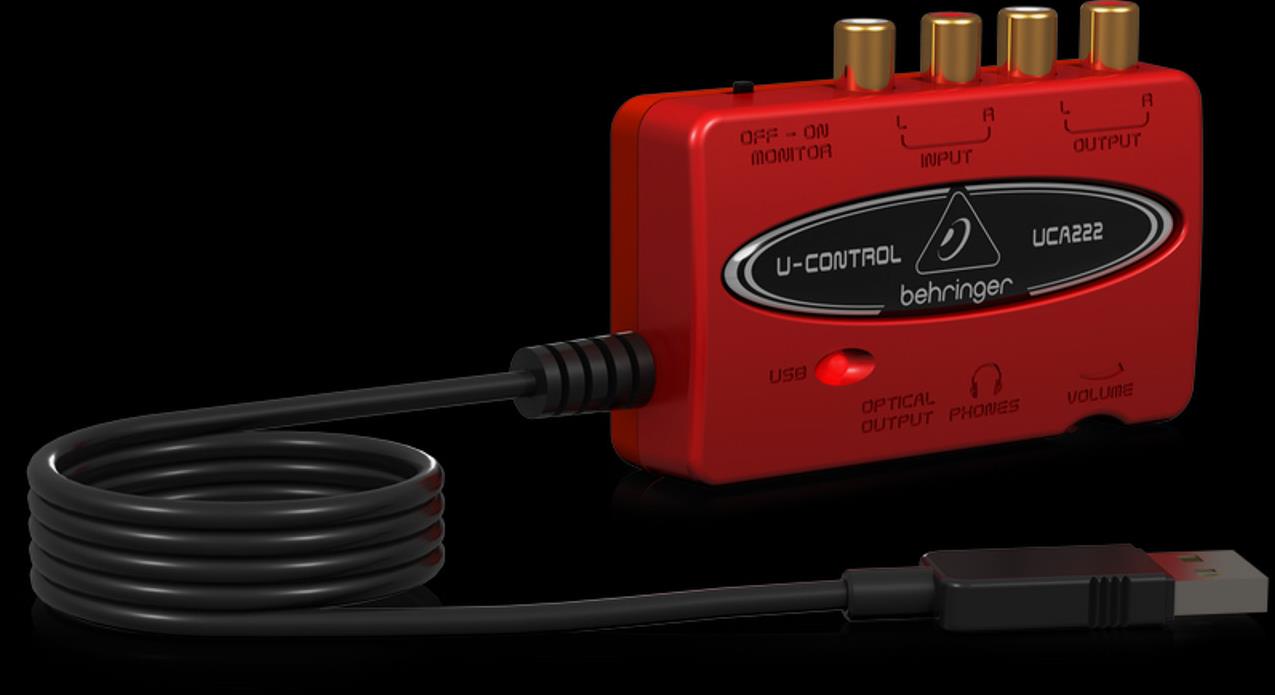
Lexicon Alpha is a compact yet professional audio interface. It features a USB I/O mixer with 2 inputs, 2 buses and 2 outputs, plus a high-impedance instrument input.
You can use this USB audio interface anywhere with a laptop. You also get Cubase® LE 5 with the Lexicon Alpha audio interface. So there’s no need to buy a separate DAW.
Lexicon Alpha features one microphone input and three line inputs.
Lexicon Alpha Features
- This audio interface features separate mic and line input level controls, plus individual peak indicators for signal management;
- Monitor mix control knob for balancing the audio between the live input and playback mix level while recording. The output can be switched to stereo or mono;
- Headphone amplifier delivers powerful and ultra-clean sound that will drive any headphones;
- Line outputs with high-pass filtering and balanced TRS.
10. Shure X2U
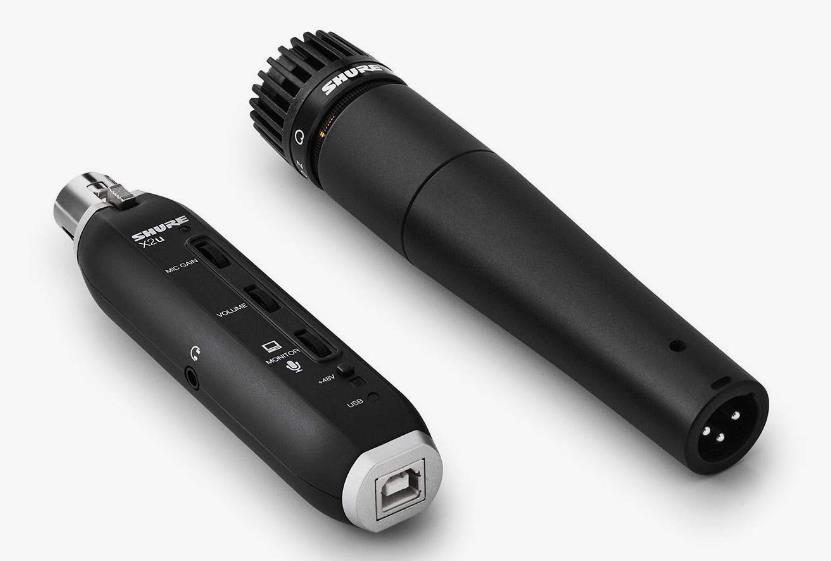
The Shure X2U is an incredible audio interface that is designed specifically for microphones. It is a tiny audio interface with a built-in male XLR port on one side that connects directly to the microphone and a USB output port on the other side that connects to your computer.
You can also connect a condenser microphone to this audio interface. It has 48V phantom power that powers the condenser microphone.
You get 3 control wheels, namely mic gain, volume, monitoring and one switch to turn phantom power on and off.
This is a 16-bit/48 kHz audio interface, so you will be a little disappointed if you want to record in HD 24-bit.
The Shure X2U is compatible with Windows Vista, XP, 2000, 7, 8, 10 and Mac OS X (10.1 or later) and you can plug it in and use it without any software.
Shure X2U Features
- It is a Plug and Play USB audio interface;
- The Shure X2U is compatible with Windows Vista, XP, 2000, 7, 8, 10 and Mac OS X (10.1 or later);
- It features a built-in preamp and independent mic input gain control;
- Zero-latency real-time playback monitoring;
- Separate headphone jack and monitor volume control;
- Monitor mix control function;
- 48V phantom power for using condenser microphones;
- Zippered carrying case and 3m USB cable.
11. Audient EVO 4 USB
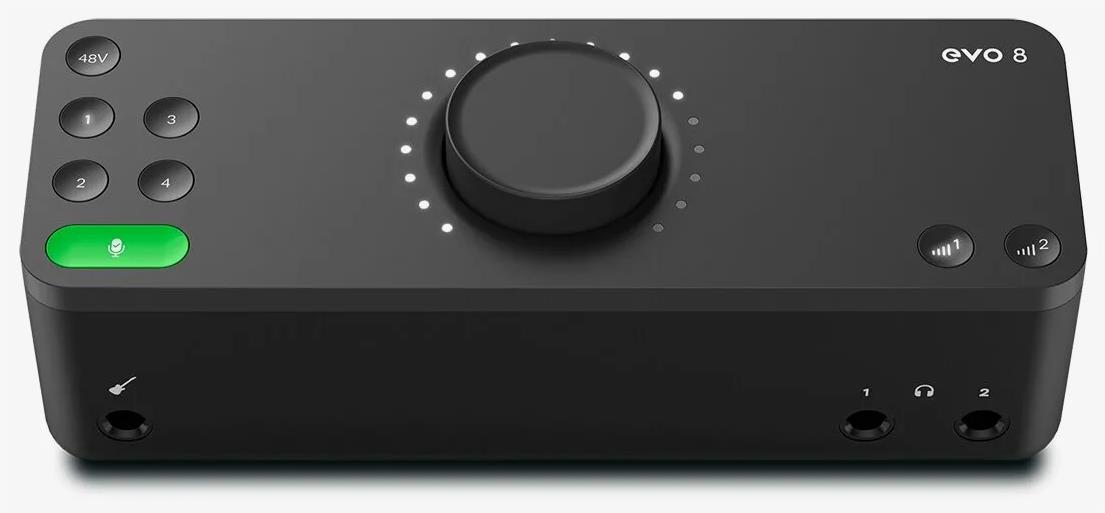
The Audient Evo 4 is a 2in/2out audio interface with +48V phantom power. It supports multiple audio recording formats up to 24-bit/96kHz.
It comes with all the software you need to start recording audio using your laptop. The mic preamp features world-class JFET Instrument Input technology, which provides more accurate audio recording for guitars and other instruments.
The Audient Evo 4 is a USB 2.0 bus-powered audio interface, so you can use it with any laptop or computer anywhere without having to plug it into a power outlet.
Audient Evo 4 USB Features
- 2 EVO mic preamps;
- World-class audio converters;
- Smart Gain technology lets you automatically configure channels;
- Smart touch points for intuitive and fast control;
- JFET Instrument Input;
- Speaker outputs;
- Separate headphone output;
- Compatible with Mac, Windows and iOS;
- Ultra-low latency monitor mix control;
- Monitor Panning;
- Audio Loopback function;
- USB2.0 bus powered;
- +48V phantom power;
- DAW-controlled mic preamps;
- Supports multiple formats up to 24-bit/96kHz;
- Lots of free software + plugins.
12. M-Audio AIR|HUB
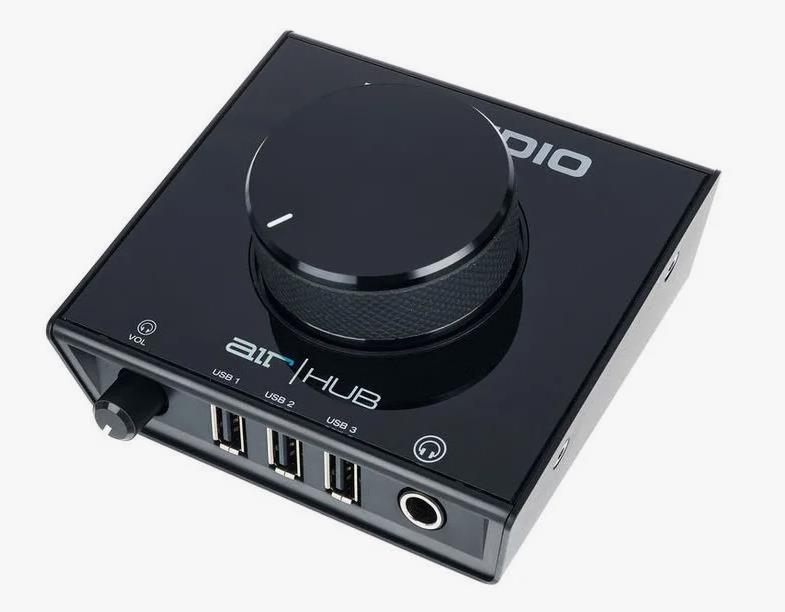
M-Audio AIR Hub is a digital audio interface that will be useful for those who play digital instruments such as digital drum machines, synthesizers, etc.
It also acts as a hub for multiple audio interfaces. This way, you can connect multiple audio interfaces to a single computer.
M-Audio AIR HUB provides 24-bit/96 kHz resolution for a professional monitoring solution, which means you can record audio in HD quality.
However, this is of no use for those who want to connect microphones and guitars to their audio interfaces. For this, you will need a separate audio interface or preamp.
Main Features of M-Audio AIR HUB
- Supports true 24-bit/96 kHz resolution for professional monitoring;
- Supports true 24-bit/96 kHz resolution for professional monitoring;
- 3 USB ports for connecting any USB equipment;
- Ideal for the studio or stage if you are using USB-enabled equipment;
- Rugged metal housing provides extra durability;
- Supports both standard USB and USB-C cables.
13. Zoom U-22

The Zoom U-22 is a portable and mobile audio interface with 2-in/2-out functionality. Compatible with Windows laptops, iPhone/iPad.
The Zoom U-22 audio interface records and plays back audio at 24-bit/96 kHz, which is better than most audio interfaces in the same price range.
It is USB bus-powered, so it can be used with any device that has a USB connection, such as a laptop, iPhone, or iPad.
The Zoom U-22 has one XLR/Phono amphibian input with 48V phantom power and Hi-Z support. The second input is 1/8″ phono.
It has 1 headphone output and 2 RCA L/R outputs for connecting external monitors.
Zoom U-22 Key Features
- Compatible with iPhone/iPad and Windows/Mac laptops;
- Extra 2 AA batteries and an AC adapter for external power;
- XLR/TRS Amphibian input with mic preamp;
- Resolution up to 24-bit/96 kHz;
- Free Ableton Live 9 Lite license;
- Hi-Z support;
- Direct zero-latency monitoring;
- RCA L/R and headphone outputs;
- Mic/instrument gain control;
- +48V phantom power.
14. Shure MOTIV MVi

If you are a guitarist and want to record your creations on your laptop, this audio interface is made for you. Shure MVi is a single-input audio interface that features one Amphibion XLR/TRS input with +48V phantom power. This means that you can use condenser microphones with this audio interface.
Well, it is not useful for stereo instruments like synths and octapads. However, you can use it to record vocals and guitar.
This compact audio interface is USB bus powered, so you can use it anywhere with a laptop without the need for an external power source.
Shure MOTIV MVi Features
- It has 5 preset DSP modes (Flat, Acoustic Instrument, Loud, Speech, Singing) that adjust EQ, compression, and limiter settings;
- Touch control panel for adjusting gain, mute, and headphone volume;
- You can use this device with the ShurePlus MOTIV app with any Mac device. It is also compatible with Windows-based computers and laptops;
- Buffered JFET Class A instrument preamplifier delivers exceptional tone and clarity in recordings;
- XLR/TRS combo input;
- 48 Volt phantom power;
- 24-bit/192 kHz audio recording resolution.
Which audio interface is best for beginners?
There’s no single answer here as it all depends on what your use case is. If you just want to record your guitar, then perhaps a single input interface will be best. If you’re podcasting, then you’ll probably want two inputs at the minimum. Audio interfaces by and large all do a similar job, and all of the interfaces in this guide will be suitable for beginners, but each is separated by a different use case to make it easier to choose.
How much should I pay for an audio interface?
Again this is all dependent on a case by case basis. Your budget should be personalized to your own needs, so if you want to record using a microphone we’d advise spending more on an interface with multiple inputs. If you’re recording music ‘in-the-box’, then you can spend a bit more on an interface that will perform with lower latency. Of course if you’re budget is super tight you may not have this choice and can only get the cheapest model available. All of the interfaces here are well below the $200/£200 mark, so well within the reach of the majority of musicians.
How many ins and outs do I need?
When you’re looking at the most affordable audio interfaces, realistically you’re not going to find a decent interface with more than two inputs and two outputs. Unless you’re planning to spend more, the most you’re going to be able to record is two mono or one stereo input/s, and outputs will be limited to – at most – a stereo pair for studio monitors and a separate headphone output. For beginners, however, this is a decent set of parameters to work within. Recording more than two sources at once will require a more fully-featured interface, with a greater number of inputs, and would automatically move out of the budget department.
What’s more important to consider is the type of ports offered. Audio interfaces will offer some variety of mic and instrument inputs, which operate at different levels and use different connection types to suit either a studio microphone lead or jack from an electric guitar, synth, drum machine, etc.
The most useful variety are ‘combo’ inputs, which can accept either lead type and will usually have a control for switching between mic and instrument levels. If you’re planning on using a mic with your interface, it’s worth checking if you need ‘phantom power’ – this is the 48v signal sent by interfaces and required by some mics. DJs should also look out for RCA connectivity, which is used to hook up DJ mixers and turntables.
What about audio interface compatability?
Every model in this best budget audio interfaces guide can be used with both Mac and PC setups, and many can also be used with Apple’s mobile iOS devices too. You will see lots of interfaces described as ‘class compliant’ which essentially means they are plug-and-pay with iPhone and iPad. Some come complete with the appropriate ‘Lightning’ connectors, while others will need Apple’s USB-to-Lightning Camera Connection Kit adapter. It’s worth doing further research before committing to a specific model, however, as Apple has a habit of dropping some functionality when it upgrades its operating systems.
Do audio interfaces come with bundled software?
Like many types of studio hardware, audio interfaces often come packaged with a variety of software to sweeten the deal. At this price, particularly if you’re just getting started, it’s worth paying attention to these bundles. Offerings range from lukewarm packages of ‘LE’ (often limited, entry-level) versions of major applications to full versions of genuinely great synths and effects. Most interfaces, particularly at this level, will bundle in a digital audio workstation (DAW), which is the software used to actually record your music into so this is super helpful if you’ve not already committed to one platform.
Cheaper audio interfaces might not boast particularly good audio and feature specs next to more expensive devices – their frequency range or sample rates might be limited, for example – but we’ll still test how they perform against our reference interfaces.
With cheaper interfaces we make allowances, knowing that they might not exhibit the sonic sparkle of higher-end interfaces – whether they do a decent job for minimal outlay. That said, you’ll be surprised just how good some budget devices are as, over the last few years, audio interface technology has really moved on in terms of what you get for your money, so you can easily get a great-sounding interface for less than $/£100.
Budget interfaces are also increasingly sold with free music software bundles, and at the lower price end you will often get tempting bundles aimed at beginners to music production – the thinking is that you get everything you need to make music from scratch out of the box.
We test this software to see if it is full or, more often than not, just a cut-down version of a full software title, so not as great value as you might first think. However, the likes of IK Multimedia, Native Instruments, and Focusrite really do deliver exceptional software bundles, ripe for beginners and with very well spec’d interfaces for the outlay.


